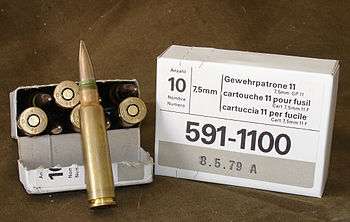Match grade

"Match grade" frequently refers to firearm parts and ammunition that are suitable for a competitive match. Sometimes, it also refers to other devices and parts that are made with high precision in mind.
Description
In firearms, the term is used to refer to ammunition and gun parts that are designed and manufactured in such a way that they have a relatively narrow tolerance and high level of accuracy. In addition to its use in shooting sports, match grade equipment is often employed by military and law enforcement sharpshooters.
Thus, many gun manufacturers use the term "match grade" to describe their products. For instance, the Heckler & Koch Mark 23 weapons system is considered so specifically tooled for combat that it is "match grade", one primary reason that the pistol and its components were selected by the USSOCOM for service.[1][2] Also, the XDM ("m" standing for "match") features components that were more advanced than those of the regular XD pistol, such as sights and the barrel, which are deemed "match grade". The magazines have extended capacities for target or combat shooting and the slide also has a more durable melonite finish for government work. SIG-Sauer has also released a line of their first ever self-defense ammunition, Elite Performance Ammunition, which they deem to be "match grade", for increased performance and reliability.[3]
Manufacturing match grade ammunition and other parts requires extremely tight tolerances and quality control. It is not unusual for match-grade ammo and parts to cost ten times more than comparable non "match" equivalents, owing both to the increased labor expended in creation and much more rigorous testing. Match grade ammunition is often subjected to higher randomized testing to increase the statistical likelihood of detecting a dud round. Match grade components are often selected by testing the performance of multiple, identically configured firearms and then eliminating those that don't perform to expectation.
It should be noted that the term "Match Grade" has no objective definition and it is commonly used to describe firearms or ammunition of varying quality and may never be found in use by professional or amateur competition shooters. For instance, both Kimber and Nighthawk Custom fit "Match Grade" triggers; it is difficult to objectively describe the quality of a trigger (even a measurement of 4.5 pounds doesn't account for creep, overtravel, pretravel and grittiness), by the same token, it is difficult to dispute the claims of either company. However, the "Match Grade" trigger on a Kimber is nowhere near the quality of that on a Nighthawk Custom. Para-Ordnance claims to use "Match Grade" barrels on even their "Elite" budget priced handguns, but the fitting of the barrel to the slide, frame, link and bushing is critical to accuracy, so the quality of the barrel may be of no consequence to the pistol's ultimate accuracy potential. Moreover, a truly match grade barrel (in use by competition shooters) from KKM or Bar-Sto will cost nearly a third of the total price of a Para-Ordnance Elite pistol, still requiring careful fitting by a skilled gunsmith, it is unlikely that such expense was taken in the manufacture or fitment of these "Match Grade" barrels. Such comparisons could be made at length, but the consumer should be aware that the term "Match Grade" carries no real, objective meaning within the firearms industry and, in many cases, it may be nothing more than the marketing department doing their job.